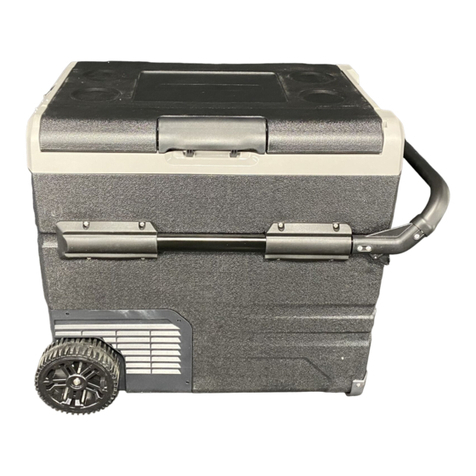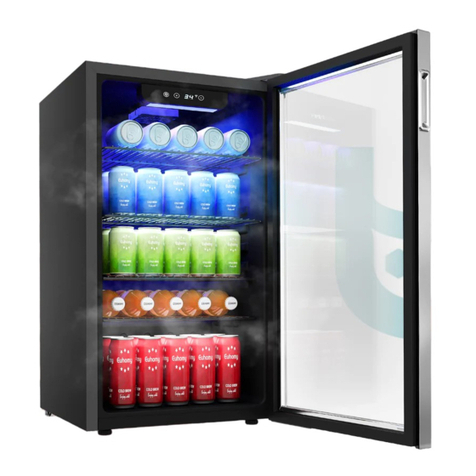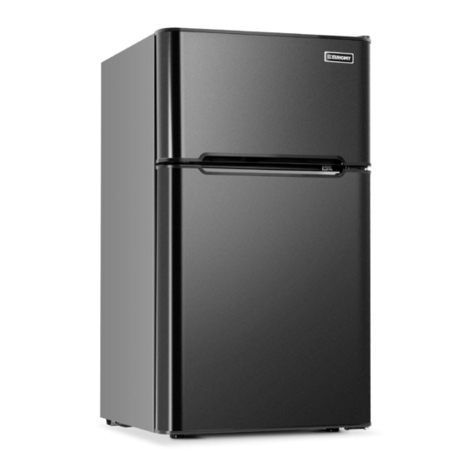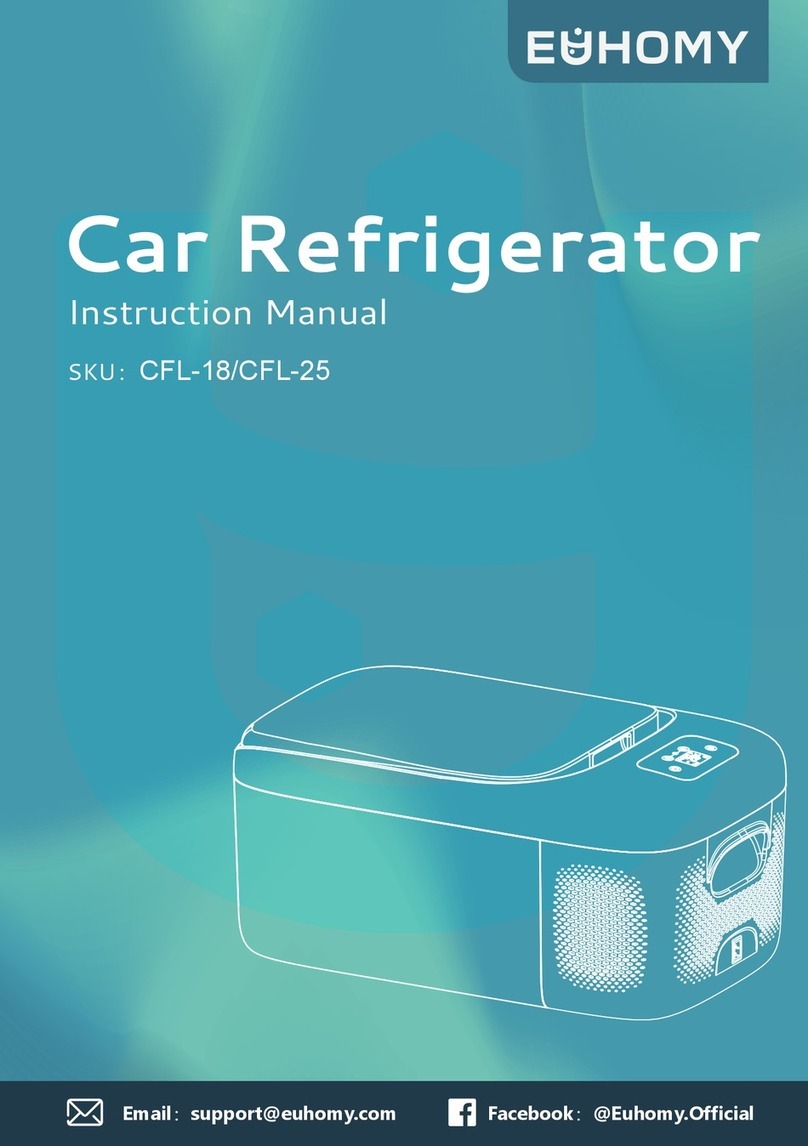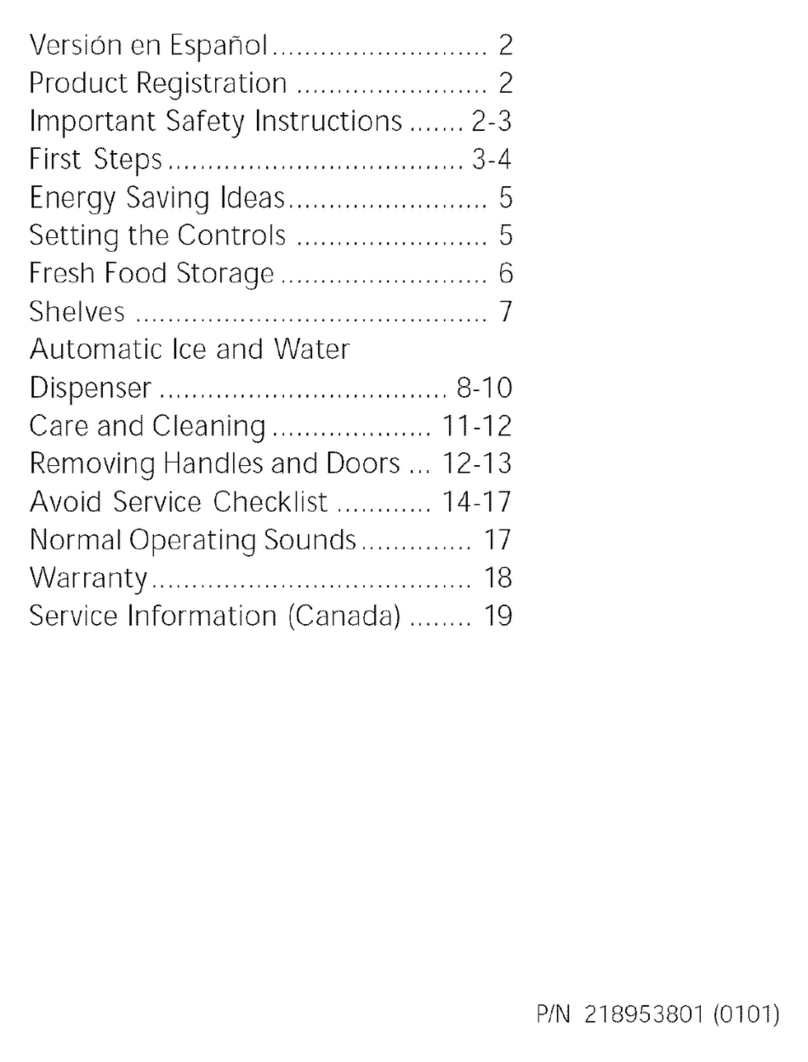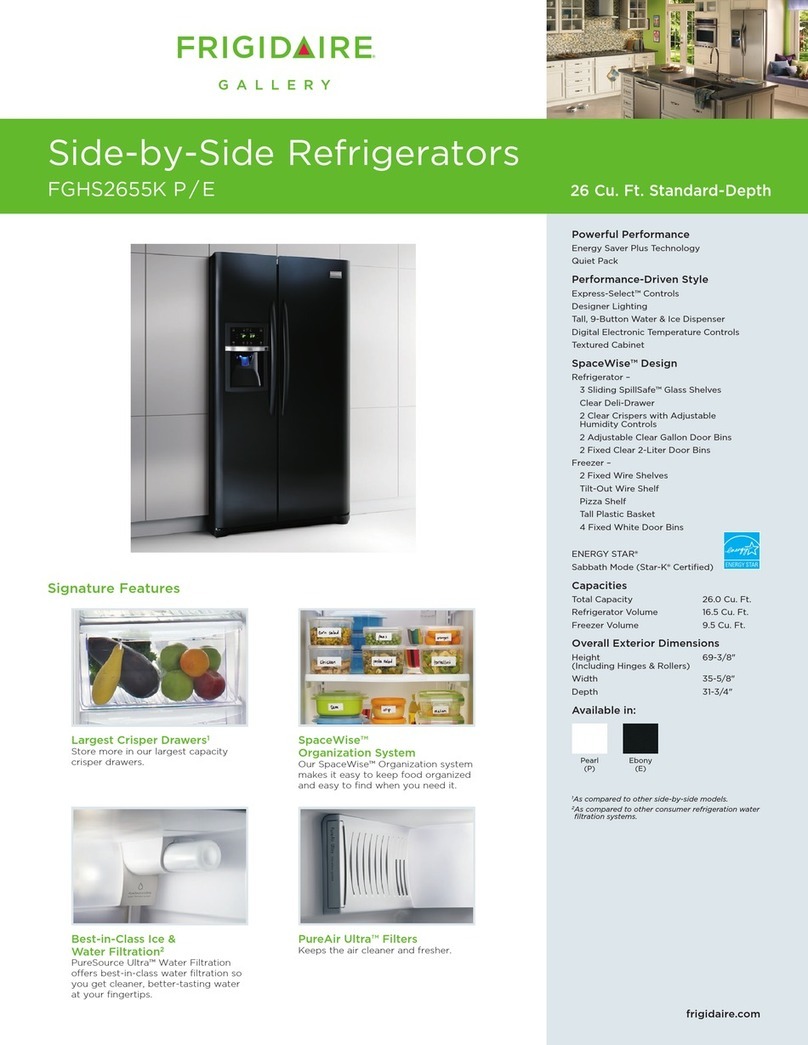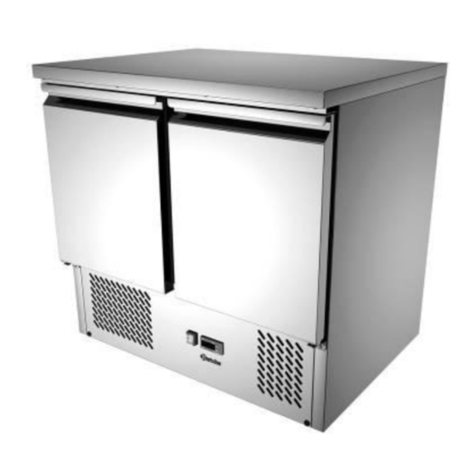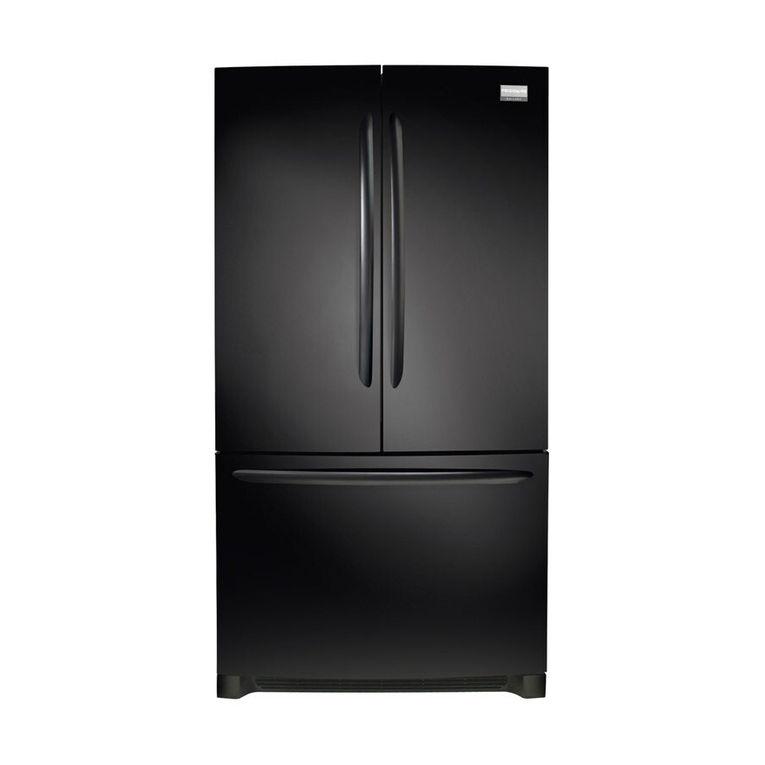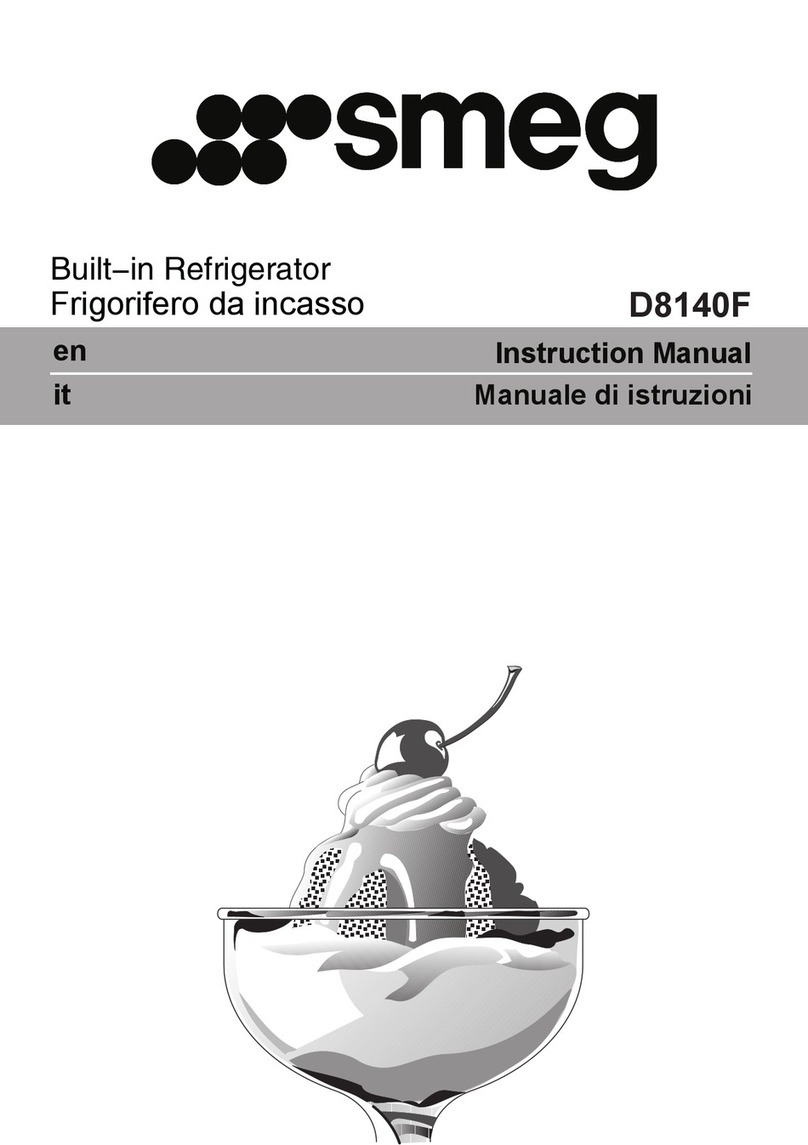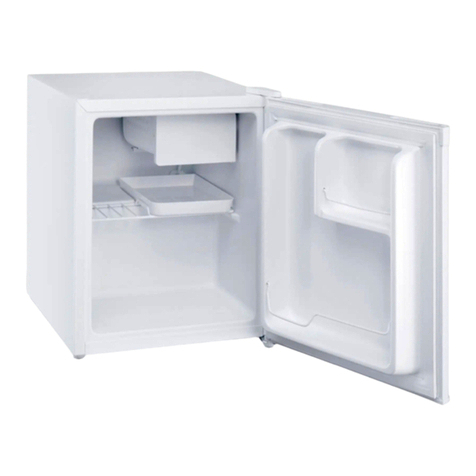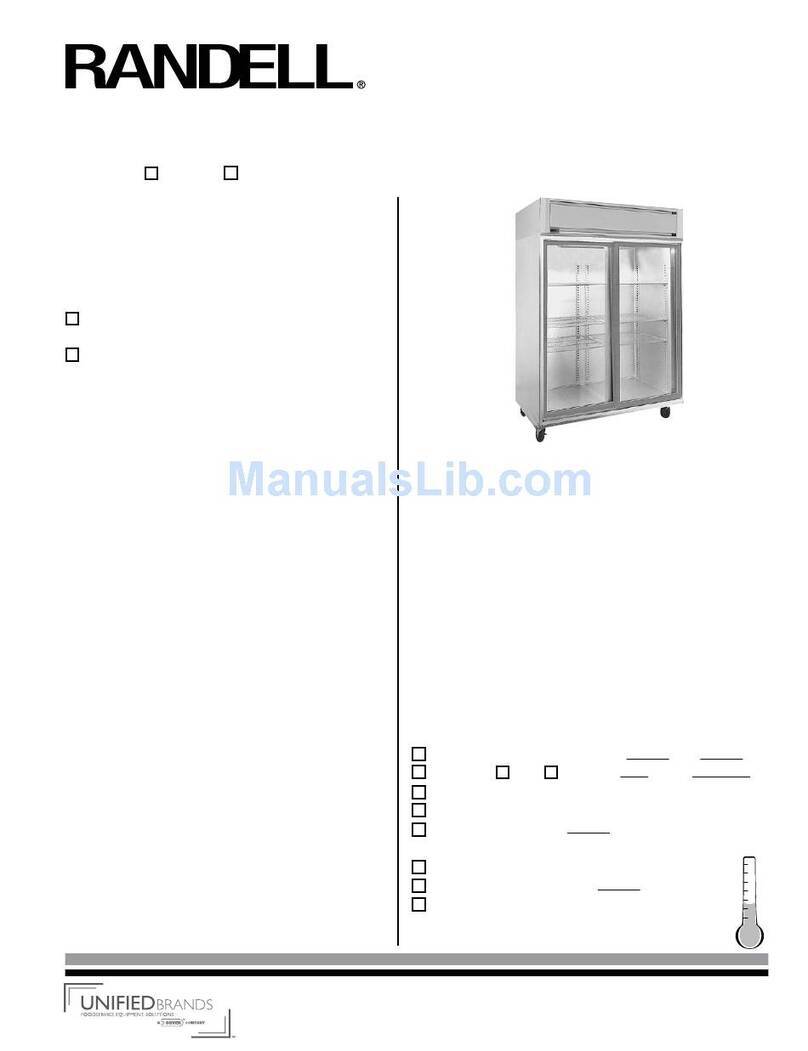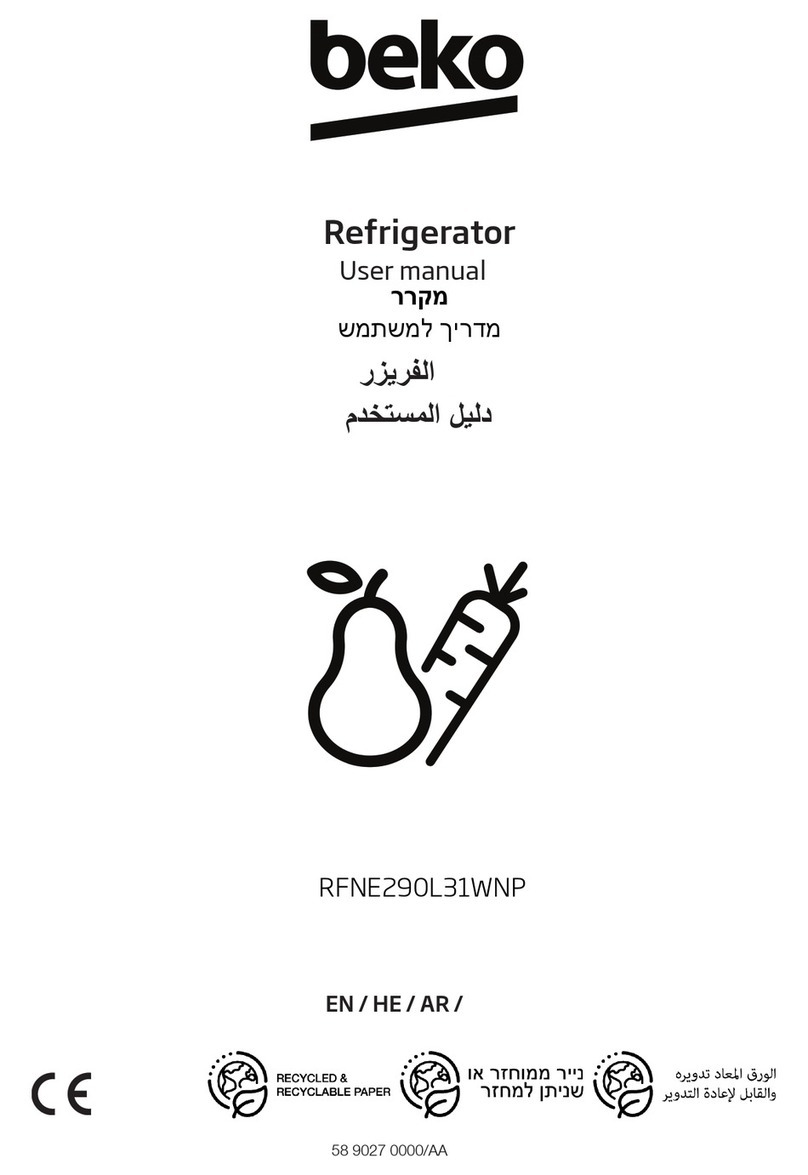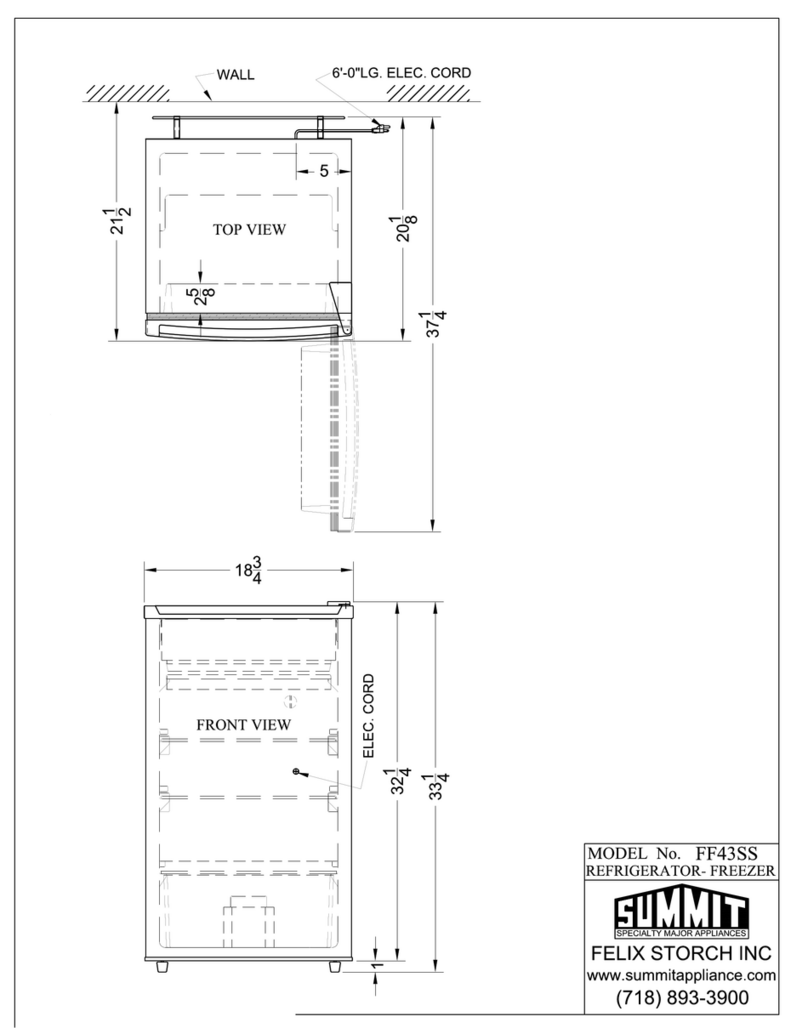Euhomy EP22672 User manual

USER'S MANUAL
EP22672
RF-S

SAFETY PRECAUTIONS
WARNING: Read all of the instructions before using this appliance.
When using this appliance, always exercise basic safety
precautions, including the following:
NOTE: If the refrigerator/freezer has been placed in a horizontal or
tilted position for any period of time wait 24 hours before
plugging the unit in.
1) Use this appliance only for its intended purpose as described in this use
and care guide.
2) This refrigerator/freezer must be properly installed in accordance with
the installation instructions before it is used. See grounding instructions
in the installation section.
3) This refrigerator/freezer should not be recessed or built-in an enclosed
cabinet. It is designed for freestanding installation only.
4) Never unplug your refrigerator/freezer by pulling on the power cord.
Always grasp the plug firmly and pull straight out from the outlet.
5) DANGER - Risk of Fire or Explosion. Flammable refrigerant used. Do
not use Mechanical devices to defrost refrigerator. Do not puncture
refrigerant tubing.
6) If your old refrigerator/freezer is not being used, we recommend that
you remove the doors. This will reduce the possibility of danger to
children.
7)
WARNING:
After your refrigerator/freezer is in operation, do not
touch the cold surfaces in the freezer compartment,
particularly when hands are damp or wet. Skin may
adhere to these extremely cold surfaces.
8) Do not refreeze foods, which have been thawed completely. The United
States Department of Agriculture in Home and Garden Bulletin No. 69
reads: "…You may safely refreeze frozen foods that have thawed if
they still contain ice crystals or if they are still cold-below 40°F".
"…Thawed ground meats, poultry, or fish that have any off-odor or
offcolor should not be refrozen and should not be eaten. Thawed ice
cream should be discarded. If the odor or color of any food is poor or
questionable, discard it. The food may be dangerous to eat."
1

2
"…Even partial thawing and re-freezing reduce the eating quality of
foods, particularly fruits, vegetables, and prepared foods. The eating
quality of red meats is affected less than that of many other foods. Use
refrozen foods as soon as possible, to save as much of they’re
eating quality as you can."
9) Do not use any electrical device or any sharp instrument in defrosting
your refrigerator.
10) Unplug your refrigerator/freezer before cleaning or before making any
repairs.
Note: If for any reason this product requires service, we strongly
recommend that a certified technician perform service.
11) Do not operate your refrigerator in the presence of explosive fumes.
SAVE THESE INSTRUCTIONS
CAUTION - Risk of Fire or
Explosion
Dispose of property in accordance with Federal or Local
Regulations. Flammable refrigerant used.
DANGER
Risk of child entrapment. Before you throw away your old
refrigerator or freezer, take off the doors. Leave the shelves
in place so that children may not easily climb inside.
English
Staple your receipt to your manual.
You will need it to obtain warranty service.
Thank you for purchasing our
product. This easy-to-use manual
will guide you in getting the best
use of your appliance.
Remember to record the model and
serial number. They are on a label
in back of the appliances.
Model number
Serial number
Date of purchase

English
TABLE OF CONTENTS
Safety Precautions........................................................................ 1
Parts And Features ....................................................................... 3
Installation Instructions ................................................................ 4
Unpacking Your Refrigerator ............................................................... 4
Leveling Your Refrigerator ................................................................... 4
Proper Air Circulation......................................................................... 4
Electrical Requirements ....................................................................... 4
Door Alignment ................................................................................. 7
Refrigerator Features and Use .................................................... 8
General Features ............................................................................... 8
Refrigerator Interior Shelves................................................................. 8
Using Dispense-A-Can ..................................................................... 8
Crisper ............................................................................................. 8
Defrosting Your Refrigerator ................................................................ 9
Food Storage Information ................................................................. 10
Normal Operating Sounds................................................................ 11
Proper Refrigerator Care and Cleaning.................................... 11
Cleaning and Maintenance............................................................... 11
Light Bulb Replacement..................................................................... 12
Power Interruptions........................................................................... 12
Vacations and Moving Care..............................................................12
Troubleshooting ..........................................................................13
Door Reversing .................................................................................. 6

3
1. Interior Light
2. Temperature Control
3. Refrigerator Shelves
4. Crisper
5. Front Leveling Legs
6. Refrigerator Door Shelves
7. "Dispense-A-Can" Storage
8. Freezer Door Shelf
9. Ice Cube Tray
10. Ice Scraper
English
Parts And Features
910
1
2
7
8
46
3
5

Installing Your Refrigerator
Unpacking Your Refrigerator
1. Remove all packaging material. This includes the foam base and all adhesive
tape holding the refrigerator accessories inside and outside.
2. Inspect and remove any remains of packing, tape or printed materials before
powering on the refrigerator.
CAUTION
Risk of Fire or Explosion due to puncture of refrigerant tubing. Flammable
refrigerant used. Handle with care when moving refrigerator to avoid either
damaging the refrigerant tubing or increasing the risk of a leak.
Leveling Your Refrigerator
• Your refrigerator has two leveling legs which are located in the front bottom
corners of your refrigerator. After properly placing your
refrigerator in its final position, you can level your refrigerator.
• Leveling legs can be adjusted by turning them counterclockwise to raise your
refrigerator or by turning them clockwise to lower your refrigerator. The
refrigerator door will close easier when the leveling legs are extended.
Proper Air Circulation
• To ensure your refrigerator works at the maximum efficiency it was designed for,
you should install it in a location where there is proper air circulation, plumbing
and electrical connections.
• The following are recommended clearances around the refrigerator:
Sides……………3/4" (19mm)
Top....................2" (50mm)
Back..................2" (50mm)
WARNING: ELECTRICAL REQUIREMENT - SHOCK HAZARD
Electrical Requirement
• Make sure there is a suitable power outlet (120 volts, 15 amps outlet) with proper
grounding to power the refrigerator.
• Avoid the use of three prong adapters or cutting off the third grounding prong
in order to accommodate a two prong outlet. This is a dangerous practice since
it provides no effective grounding for the refrigerator and may result in shock
hazard.
WARNING: USE OF EXTENSION CORDS- POTENTIAL SAFETY
HAZARD
4
English

Use of Extension Cords
• Avoid the use of an extension cord because of potential safety hazards under
certain conditions. If it is necessary to use an extension cord, use only a 3-wire
extension cord that has a 3-blade grounding plug and a 3-slot outlet that will
accept the plug. The marked rating of the extension cord must be equal to or
greater than the electrical rating of the appliance. DO NOT USE
EXTENSION CORD LONGER THAN 12 FT.
Installation Limitations
• Do not install your refrigerator in any location not properly insulated or heated,
e.g. garage, etc. Your refrigerator was not designed to operate in temperature
settings below 55˚ Fahrenheit.
• Select a suitable location for the refrigerator on a hard even surface away
from direct sunlight or heat source, e.g. radiators, baseboard heaters, cooking
appliances, etc. Any floor unevenness should be corrected with the leveling legs
located on the front bottom corners of the refrigerator.
5
English
WARNING: USE OF EXTENSION CORDS- POTENTIAL SAFETY
HAZARD

1. Ensure the unit is unplugged before starting door reversal.
2. Remove the 2 plug buttons on the left side on top of the cabinet.
3. Remove the plastic hinge cover by prying from the back
and pulling forward.
4.
Remove the 2 screws from the top hinge.
5. Lift the freezer door up and off the center hinge (right
side).Set the freezer door on a nonscratching surface
with the outside up.
6.
Open the fresh food door and remove the center hinge
by removing the 2 screws. Lift the hinge to remove.
7. Lift the fresh food door off of the bottom hinge. Set the
fresh food door on a non-scratching surface with the outside up.
8. Lay the refrigerator on its back to access the bottom hinge.
Plug
Buttons
Plug
Buttons
Center
Hinge
Center
Hinge
Bottom
Hinge Hinge
Pin Hinge
Pin Bottom
Hinge
Hinge and
Cover
Hinge and
Cover
Follow all s teps when reversing the door swing. Failure
to follow these instruction s, leaving off pa rts, or overtightening screws,
can lead to the door falling off and result in injury and p roperty damage
.
Installation Requirements
Door Reversing (Optional)
English
Turn
Turn
WARNING:
9. Remove the bottom hinge by removing the 3 screws.
Lift the hinge to remove.
10. Remove the hinge pin on the bottom hinge and
reinstall on the opposite side of the hinge.
6

Installtion Instructions
REVERSE DOOR (Optional) (Cont.)
11. Remove the 2 screws from the left side and relocate to the right side,replace the.
12. Remove the two plug buttons on the left side at the center and install them on
.
13. Turn and relocate the center hinge to the left side and reinsert screws.
Do not tighten screws yet.
14. Align the fresh food door on the left center hinge. With the magnetic
gasket holding the door in place, make sure the door is aligned with the
refrigerator, and secure the bottom hinge on the left with 3 screws.
15. Ensure fresh food door is properly sealed and leveled before tightening
the center hinge screws and the bottom hinge screws.
16. Raise the refrigerator to the upright position.
17. Place the freezer door on the center hinge over the pin. Ensure the door
is aligned horizontally and vertically, and that the gasket seals on all sides.
18. Turn and relocate the top hinge on the left side with screws.
19. Replace the hinge cover on top of the hinge by sliding it from front to back.
20. Put the 2 plug buttons on the right side on top of the cabinet.
21. Open and close both the freezer and fresh food doors several times to
confirm each door is positioned correctly and the gasket is sealed well. If
this is not the case, please adjust the door again.
22. Wait at least 30 minutes before plugging in the refrigerator to allow the
refrigerant to settle down. Then plug in the unit.
Door Alignment
Freezer Door: (see fig. #1)
1. Remove the top hinge cover.
2. Loosen the top hinge screws using a phillips head screwdriver.
3. Adjust the door or put a spacer in between and then tighten the screws.
4. Replace the top hinge cover.
1
0
2
3
4
5
6
7
fig. # 1
the right
English
7
plastic locker on the fresh door and freezer door bottom in the spare bag.

8
English
Refrigerator Features And Use General Features
Adjustable temperature dial:
Your refrigerator will automatically maintain the temperature level you select.
The temperature control dial has 7 settings plus 0. 1 is the warmest. 7 is the
coldest. Turning the dial to 0 Stops cooling in both the refrigeration and freezer
sections. At first, set the dial to 4 and allow 24 hours to pass before adjusting the
temperature to your needs.
(Note: If the refrigerator has been placed in a horizontal or tilted position for
any period of time wait 24 hours before plugging the unit in.)
Refrigerator Interior Shelves
To remove or replace a full-width
slide-out shelf:
(see fig. # 2)
1. Gently tilt the shelf up and slide
forward until the shelf has been
completely removed.
2. To replace the shelf, gently slide the
shelf back.
Using the Dispense-A-Can
• Your refrigerator is equipped with the convenient “Dispense-
A-Can” compartment. Each compartment will hold up to six
cans. Simply load the cans from the top. To dispense a can,
simply draw one out from the bottom. It is that easy.
Crisper
• Your refrigerator has a clear crisper.
Grasp the top of the crisper and gently slide our. Push back to replace.
fig. # 2
fig. # 3

9
English
Defrosting Your Refrigerator
• For maximum energy efficiency, defrost freezer
section whenever frost accumulates to a
thickness of 1/4" or more on freezer walls.
Note that frost tends to accumulate more
during the summer months.
DANGER - Risk of Fire or Explosion due to puncture refrigerant
tubing. Flammable refrigerant used. Do not use metal instruments
to defrost refrigerator. Do not puncture refrigerant tubing.
• To defrost freezer, remove food and ice cube tray from the freezer section. Turn
temperature control dial to "0" position. Defrosting may take a few hours. To
speed up defrost time, keep the door open and place a bowl of warm water in
the freezer.
• During the defrost, water will accumulate. Use a towel to wipe off excess
dripping water. Do not leave unattended.
• After defrosting, empty and wipe down the interior of the freezer. You may now
reset your refrigerator to the desired temperature and return food.
• Your freezer has been equipped with an ice scraper for your convenience.
Maintenance
Risk of Fire or Explosion. Flammable refrigerant used. Do not puncture of
refrigerant tubing. To be repaired only by trained authorized service personnel.
Consult Repair Manual before attempting to service this product. All Safety
Precautions Must be followed. Component parts shall be replaced with like
components to minimize the risk of possible ignition due to incorrect parts or
improper service.

English
10
Fresh Food:
• When storing fresh food that is not prepackaged, be sure to wrap or store food
in airtight and moisture proof material unless otherwise noted. This will ensure
proper shelf life and prevent the transfer of odors and tastes.
• Wipe containers before storing to avoid needless spills.
• Eggs should be stored in an upright position in their original carton to
maximize shelf life.
• Fruit should be washed and dried, then stored in sealed plastic bags before
storing in the refrigerator.
• Vegetables with skins should be stored in plastic bags or containers.
• Leafy vegetables should be washed and drained and then stored in plastic
bags or containers.
• Hot food should be allowed to cool before storing in the refrigeration. This will
prevent unnecessary energy use.
• Fresh seafood should be used the same day as purchased.
• When storing meats in the fresh food section, keep in the original
packaging or rewrap as necessary. Follow the suggestions below for safe
storage:
• Chicken 1-2 Days
• Ground Beef 1-2 Days
• Cold Cuts 3-5 Days
• Steaks/Roasts 3-5 Days
• Smoked/Cured Meats 7-10 Days
For detailed storage chart visit FDA website:
www.cfsan.fda.gov/~dms/fttstore.html
Food Storage Information

11
English
Frozen Food:
•Wipe containers before storing to avoid needless spills.
• Hot food should be allowed to cool before storing in the freezer.
This will prevent unnecessary energy use.
• When storing meats, keep in the original
packaging or rewrap as necessary.
• Proper freezer storage requires correct packaging. All foods must be in pack-
ages, which do not allow the flow of air or moisture in, or out. Improper stor-
age will result in odor and taste transfer and will result in the drying out of the
improperly packaged food.
• Follow package or container instructions for proper storage.
• Packaging Recommendations:
Plastic containers with air tight lids
Heavy duty aluminum foil
Plastic wrap made from saran film
Self-sealing plastic bags
• Do not refreeze defrosted/thawed foods.
• It is recommended that the freezing date be marked on the
packaging.
These are some suggestions for safe storage:
• TV Dinners 3 - 4 Months
• Fresh Shrimp, scallops, crawfish 3 - 6 Months
• Hamburger & stew meats 3 - 4 Months
• Ground Turkey, veal, pork 3 - 4 Months
• Chops 4 - 6 Months
• Steaks 6 - 12 Months
• Chicken or turkey, whole 1 year
For detailed storage chart visit FDA website:
www.fda.gov

12
English
Normal Operating Sounds You May Hear
• Boiling water, gurgling sounds or slight vibrations that are the result of
the refrigerant circulating through the cooling coils.
• The thermostat control will click when it cycles on and off.
Proper Refrigerator Care and Cleaning
Cleaning and Maintenance
WARNING: To avoid electric shock, always unplug your
refrigerator before cleaning. Ignoring this warning
may result in death or injury.
CAUTION: Before using cleaning products, always read and
follow manufacturer’s instructions and warnings to
avoid personal injury or product damage.
General: Prepare a cleaning solution of 3-4 tablespoons of baking soda
mixed with warm water. Use sponge or soft cloth, dampened
with the cleaning solution, to wipe down your refrigerator.
• Rinse with clean warm water and dry with a soft cloth.
• Do not use harsh chemicals, abrasives, ammonia, chlorine
bleach, concentrated detergents, solvents or metal scouring
pads. Some of these chemicals may dissolve, damage and/or
discolor your refrigerator.
Door Gaskets: Clean door gaskets every three months according to general
instructions. Gaskets must be kept clean and pliable to assure a
proper seal
• Petroleum jelly applied lightly on the hinge side of gaskets will
keep the gasket pliable and ensure a good seal.
Light Bulb Replacement
1. Switch off power to refrigerator.
2. Gently pull out the clear cover
3. Replace with same type light bulb rated at 10 watts.
4 . Push the clear cover back into place.
Power Interruptions
• Occasionally there may be power interruptions due to thunderstorms or
other causes. Remove the power cord from AC outlet when a power outage
occurs. When power has been restored, replug power cord to AC outlet.
If outage is for a prolonged period, inspect and discard spoiled or thawed
food in freezer and refrigerator. Clean refrigerator before reusing.
WARNING: IF OUTAGE IS FOR A PROLONGED PERIOD, INSPECT
AND DISCARD SPOILED OR THAWED FOOD IN
FREEZER AND REFRIGERATOR. CLEAN REFRIGERATOR
BEFORE REUSING.

Refrigerator does not operate:
•Check if thermostat control is not in the “0” position.
•Check if refrigerator is plugged in.
• Check if there is power at the AC outlet, by checking the circuit breaker.
Food temperature appears too warm:
•Frequent door openings.
•Allow time for recently added warm food to reach fresh food temperature.
•Check gaskets for proper seal.
•Adjust temperature control to colder setting.
Food temperature is too cold:
• If temperature control setting is too cold, adjust to a warmer setting and allow
several hours for temperature to adjust.
Refrigerator runs too frequently:
• This may be normal to maintain constant temperature during high temperature
and humid days.
• Doors may have been opened frequently or for an extended period of time.
•Check gasket for proper seal.
•Check to see if doors are completely closed.
Moisture build up on interior or exterior of the refrigerator:
•This is normal during high humidity periods.
•Prolonged or frequent door openings.
•Check door gaskets for proper seal.
Refrigerator has an odor:
•Interior needs cleaning.
•Foods improperly wrapped or sealed are giving off odors.
13
English
Troubleshooting
Vacation and Moving Care
• For long vacations or absences, empty food from refrigerator and freezer,
move the temperature DIAL to the OFF position and clean the refrigerator and
door gaskets according to "General cleaning" section. Prop doors open, so air
can circulate inside.When moving always move the refrigerator vertically. Do
not move with the unit lying down. Possible damage to the sealed system could
occur.

14
English
Refrigerator door does not shut properly:
•Level the refrigerator.
•Re-align refrigerator door.
• Check for blockages, e.g. food containers, crisper cover,shelves, bins, etc.
Popping or cracking sound when the compressor comes on:
•Check to ensure the refrigerator is level.
• The floor may be uneven or weak. The refrigerator rocks on the floor when it is
moved slightly. Be sure the floor can adequately support the refrigerator. Level the
refrigerator by putting wood or metal shims under part of the refrigerator.
• The refrigerator is touching the wall. re-level the refrigerator and move it from the
wall. See the “Installing Your Refrigerator” section.
Refrigerator light does not work
•Check power supply.
•Tighen bulb in socket.
• Replace burned out bulb.
Table of contents
Other Euhomy Refrigerator manuals


